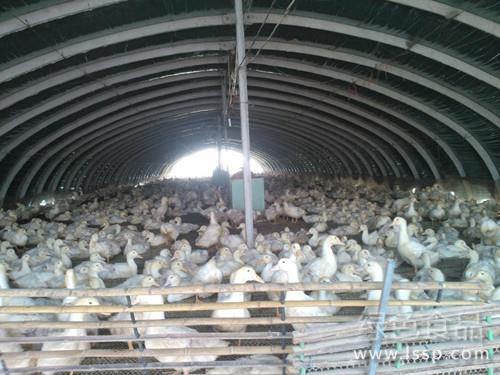Rapid weight gain of meat duck in greenhouse breeding and management of meat duck in greenhouse
After the ducklings grow to 3 weeks of age, they enter the breeding period. During this period, the feathers of meat ducks have basically covered the whole body, and the cold resistance is enhanced. Except in cold season, no additional heating equipment is needed. This period meat duck skeleton and muscle growth exuberant, digestive function has been sound, feed intake greatly increased, weight gain quickly. In feeding management, seize this characteristic, so that meat ducks quickly reach the weight of the market.

Meat duck in greenhouse
1. Feeding during transition period: 1. Temperature. Duck houses are generally not heated, but when the temperature difference between the natural temperature and the brooding room at the end of 5℃ or more, it will cause diseases such as colds in meat ducks. Therefore, duck houses should be appropriately heated in the first few days when the group is transferred in winter.
2. Empty stomach transfer. 8 hours before the transfer group, stop feeding, such as meat ducks after fasting can be transferred out, but stop eating. No water.
3. Prevent stress. One day before and three days after group transfer, multivitamins or anti-stress electrolytes should be added to the feed to prevent stress caused by group transfer until the ducks eat normally after group transfer.
2. Change feed: 1. 3-5 days before transfer to breeding house, gradually change duckling feed to breeding feed, not too suddenly, otherwise it is easy to cause digestive system disorder of meat duck and affect the growth speed of meat duck. In order to make meat ducks adapt to the new feed slowly, 30% of the young duck feed was mixed into the young duck feed on the first day of refeeding, increased to 60% on the second day, increased to 80% on the third day, and all the young duck feed was fed from the fourth day.
2. Meat ducks grow fast and eat large amounts of feed during the breeding period. Generally, feed with low nutrient concentration can meet the demand, so the protein content of feed during the breeding period is about 16%.
3. Adjust feeding density: 1. Meat duck grows fast, reaching more than 1300 grams at 21 days old. In order to adapt to the rapid growth characteristics of meat ducks, the breeding space should be increased during the breeding period, the unit feeding density should be reduced, and the production efficiency should be improved. The specific methods should be determined according to the feeding methods. If the ground flat culture method is adopted throughout the breeding period, the protective plate can be removed during the breeding period and the breeding density can be adjusted directly to the level of 5 or 6 per square meter. If the whole feeding period adopts online feeding mode, the feeding density can be adjusted to 7~8 ducks per square meter directly during the breeding period, and the feeding density can also be adjusted at any time according to the age of meat ducks. Such as brood period with online feeding, breeding period with ground flat, due to the sudden increase in feeding space and changes in ground structure, meat ducks will run, often sprained and twisted feet. Sprain duck, if not dealt with in time, will be trampled or killed by other meat ducks. Therefore, when adjusting the ground space, there should be a process of change, first small and then large, so that it can adapt to the environment, and then expand the feeding space.
2. If sprained meat ducks are found, they should be isolated in time and raised separately. After the injury recovers, they should be mixed. When adjusting density, meat ducks should be grouped according to size and strength. Weak ducks with small weight and slow growth should be fed intensively, and management should be strengthened to make them catch up with strong ducks of the same age quickly without affecting the sale date.
IV. Prevention and control of epidemic diseases: 1. Do a good job of disinfection to prevent the spread of diseases. Pay attention to keep the duck shed and playground well drained, the ground dry, and clean every day, the bedding is often replaced, the trough and drinking water container are often washed; in case of infectious diseases, quickly isolate sick ducks, do not throw dead meat ducks, disinfect the contaminated places immediately, commonly used disinfectants: quicklime, plant ash, lysol, caustic soda, No.5 disinfectant, potassium permanganate, poison, etc.
2. Pay attention to the dynamics of meat ducks and detect the disease early. Early morning, noon, late night and between feedings are good times to check duck flocks. Healthy meat duck, strong physique, full of spirit, lively action, compact feathers, luster, bright eyes, clean eyelids, strong appetite, normal feces, stable breathing.
Related
- On the eggshell is a badge full of pride. British Poultry Egg Market and Consumer observation
- British study: 72% of Britons are willing to buy native eggs raised by insects
- Guidelines for friendly egg production revised the increase of space in chicken sheds can not be forced to change feathers and lay eggs.
- Risk of delay in customs clearance Australia suspends lobster exports to China
- Pig semen-the Vector of virus Transmission (4)
- Pig semen-the Vector of virus Transmission (3)
- Five common causes of difficult control of classical swine fever in clinic and their countermeasures
- Foot-and-mouth disease is the most effective way to prevent it!
- PED is the number one killer of piglets and has to be guarded against in autumn and winter.
- What is "yellow fat pig"? Have you ever heard the pig collector talk about "yellow fat pig"?



